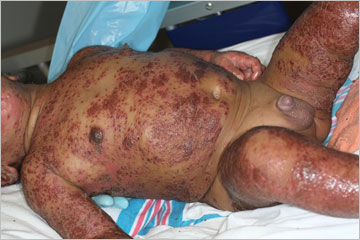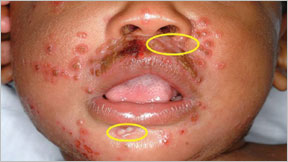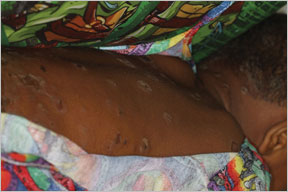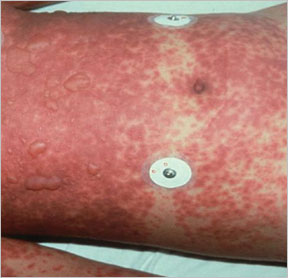A 13-month-old male with exacerbated eczema
Click Here to Manage Email Alerts
A 13-month-old male with a history of moderately severe eczema, diagnosed in early infancy, awoke with an exacerbation of his rash with subjective fever. He had been somewhat fussy for the previous 2 days, but his appetite was unchanged. His usual medications include Cetaphil (a water-based moisturizer lotion) and Aquaphor as a barrier ointment. However, because of this exacerbation, his parents sought the advice of a neighbor, who also has a child with mild eczema and who had just recovered from a case of hand-foot-and-mouth (HFM) disease. The neighbor suggested using some of her leftover “white lotion” that she had used to treat her child’s HFM disease. This lotion was applied to the patient at bedtime. The next morning, the patient felt more febrile and the rash was much worse, with numerous “bumps all over,” which prompted a visit to the local community hospital ER, where a temperature of 102.2°F was confirmed. Thinking the child may have progressive erythema multiforme or toxic epidermal necrolysis (TEN), he was given a dose of IV vancomycin and transferred to our children’s hospital PICU.


Source: James H. Brien, DO
Other than the eczema, his past medical history was unremarkable, with no unusual or severe infections or other noteworthy problems. He takes no medications except the topical products noted above. The only sick contact was the next-door neighbor’s child who recently had HFM disease.

Examination in the PICU revealed a very fussy, crying baby with a temperature of 101.1°F and a pulse of 175. His exam was positive for the skin findings of widespread, large, inflamed confluent areas of weeping erosions and papules from the face to feet (Figure 1), with the diaper area relatively spared. Also, some vesiculopustular lesions were seen about the ankles (Figure 2). There were no other similar lesions seen, but the skin was so damaged and distorted, it would be hard to tell. All mucous membranes were clear, except for a single ulcer on the tip of the patient’s tongue.
Lab tests on admission included a normal comprehensive metabolic panel and UA, but the CBC revealed a WBC count of 15.7, with 25% neutrophils, 7% bands, 32% lymphocytes and 20% eosinophils. Other tests included samples of an ankle pustule and one of the erosions for varicella and herpes simplex virus (HSV) PCR, which were negative, as well as a negative blood culture. However, a bacterial culture of a skin lesion grew methicillin-sensitive Staphylococcus aureus. Another ankle pustule sample was sent for enterovirus PCR, which was positive.
What’s your diagnosis?
A. Eczema coxsackium
B. Disseminated S. aureus pyoderma
C. Toxic epidermal necrolysis
D. Eczema herpeticum
Case Discussion
With the pustule testing positive by PCR for enterovirus, there was reasonable evidence for eczema coxsackium (A). Coxsackie A16, an enterovirus, is the cause of most cases of HFM disease. We have seen several cases of disseminated HFM disease in children with moderately severe eczema, and I jokingly referred to cases like this on rounds as eczema coxsackium, mimicking the older term, eczema herpeticum. Then, come to find out, it was a legitimate, published term (Erin Mathes, MD, et al, Pediatrics, July 2013). We do not have the resources to type the virus, to know if it was A16 or the more severe form due to A6, or one of the many other enteroviruses, so I made a reasonable extrapolation in this case. Therapy is directed to intensification of skin care and preventing secondary infection.



The negative HSV PCR should help rule out eczema herpeticum. A clinical clue might be the pustules about the ankles, and the ulcer on the tongue. Nonetheless, herpes could look the same. However, with herpes, I would expect to see more vesicles or pustules in other locations (Figure 3). Lastly, an important historic tip was the exposure to a neighbor with HFM disease. The neighbor’s cream used the night before probably had nothing to do with transferring the virus, but rather contact with the neighbor’s child 3 to 6 days earlier (the incubation period). Until HSV can be ruled out with confidence, it is always prudent to treat with acyclovir.
Disseminated S. aureus pyoderma in a patient with eczema was featured in the August 2016 issue of IDC. Heavy colonization with S. aureus is common in children with eczema/atopic dermatitis, which is also thought to be an aggravating factor behind flare-ups. In the August 2016 case, the staph appeared to be an epidermolytic toxin-producing strain, with multiple small blisters (Figure 4), making the diagnosis disseminated bullous impetigo with eczema. Treatment is with an anti-staph antimicrobial agent and decolonization (as much as possible).
TEN should not be in the differential. It is a reaction to a drug, such as a sulfa, that results in severe damage to the skin at the subepidermal level, causing widespread blistering (Figure 5), and should usually be managed in a burn unit or equivalent facility. The patient presenting had no blisters. TEN is one of those conditions that, once seen, you never forget.
- Reference:
- Mathes EF, et al. Pediatrics. 2013;doi:10.1542/peds.2012-3175.
- For more information:
- James H. Brien, DO, is with the department of infectious diseases at McLane Children’s Hospital, Baylor Scott & White Health, Texas A&M College of Medicine in Temple, Texas. He also is a member of the Infectious Diseases in Children Editorial Board. Brien can be reached at jhbrien@aol.com.
Disclosure: Brien reports no relevant financial disclosures.
Columnist comment:
Chronically damaged skin can promote the spread of other pathogens as well, such as the poxvirus responsible for Molluscum contagiosum. I have not seen a clever name for that, but I might propose eczema molluskium. Oh wait, it’s already been named eczema molluscatum. However, I cannot find a reference that takes credit, so my suggestion is just as good, unless an English major informs me otherwise. Someone let me know.
